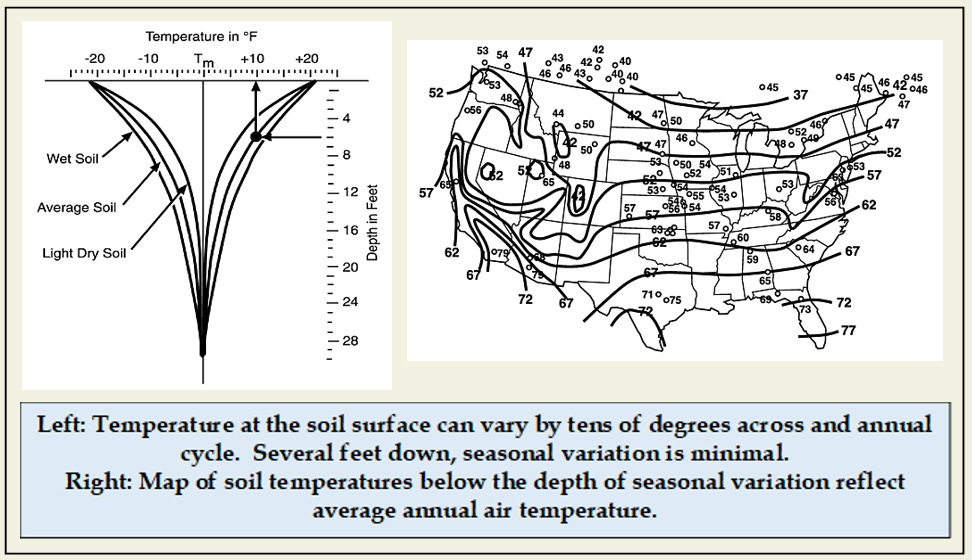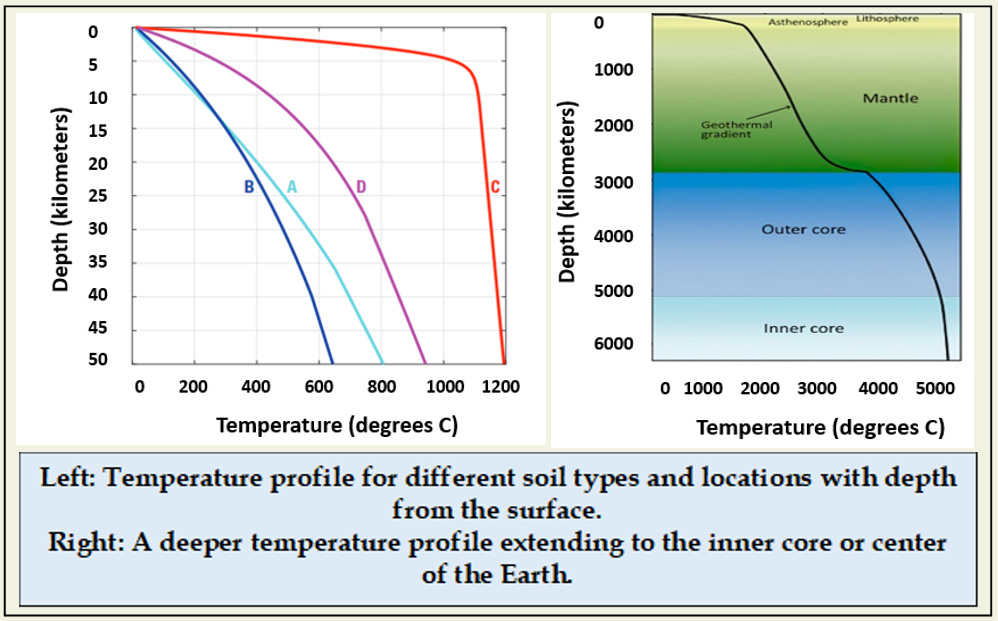Two recent reports warranted a new look here at the potential of energy from below ground. The first uses geothermal/heat pump systems at the community level, and the second hopes to tap extreme temperatures thousands of feet below the surface to generate electricity.
Geothermal Energy: Heat From The Earth
Solar and nuclear energy are often proposed as solutions to our energy and climate crisis.
When we think of these sources, we may picture huge encasement domes to control the nuclear fission reactions generating heat, steam and electricity, or vast fields of solar panels gathering photons gifted to us by the sun.
But what if we could harness nuclear and solar energy by tapping into the solid Earth beneath our feet.
What these unlikely-seeming possibilities share is the term geothermal; literally heat from the Earth. Where does geothermal energy come from and how can we tap it? Is it really a valuable alternative?
More on the sources of this energy in a bit, but first, there are three vastly different ways to capture this heat energy. Two are familiar and in common use, and one is experimental but may hold the greatest potential.
Volcanic Geothermal Energy
The most dramatic form of geothermal energy, and what may come to mind first, is the high-energy heat and steam generated by near-surface volcanic activity. Iceland is the poster child for tapping this source as it sits atop a rare volcanic “hot spot” and astride the Mid-Atlantic Ridge at the boundary between the North American and Eurasian tectonic plates. As a result, it is one of the most geologically active places on Earth, with more than 45 volcanic eruptions since 1900.
When this geologic heat interacts with underground aquifers, it generates steam which also erupts to the surface, and can be tapped to heat buildings directly and to drive turbines that generate electricity for the nation.
By tapping this source, and hydroelectric power as well, Iceland has developed an electrical industry that is essentially carbon-free. Nine power plants use geothermal steam to generate 75% of total national demand.
Consider for a moment how much energy is required to actually move continental-size tectonic plates across the face of the Earth, creating this intense volcanic activity as something of a by-product. What is the source of that tremendous amount of energy? We’ll come back to that in a bit.
Unfortunately, Iceland’s situation is the exception and not the rule. While regions of volcanic activity are not uncommon, most of the heat is too deep or too hazardous or too inconsistent to be tamed for this purpose. In the U.S., there are 93 power stations that draw steam and energy directly from volcanic activity, all in 7 western states. Together they provide only 0.4% of total U.S. electric generation.
Geothermal Heat Pumps
The second familiar form of geothermal energy could not be more different from the eruptive steam streams that power Iceland. This is the universally distributed low-grade heat stored in shallow soils that can be multiplied by heat pumps.
Temperatures in any surface soil can vary widely across the seasons, but that variation is damped as you go deeper. Within feet of the surface, soil temperature remains near the average annual temperature at that location.
Even in the depths of winter in the northernmost parts of the U.S., the soil temperature several feet down will be well above freezing. This is why the pipes bringing water to your home need to be buried below that depth of frost penetration - to protect those pipes from bursting.
So water pipes buried deeply enough to reflect that annual average temperature can absorb heat from that soil and return the water to the surface at that average temperature.
But can you heat a house in northern Maine using 47 degree water? This is where heat pumps come in.
Heat pumps are basically reversible versions of your window air conditioner. A compressor is used to drive the condensation/evaporation cycle of a contained refrigerant capable of extracting heat from cold air or water (yes, it does seem kind of miraculous, as described in that link above).
Engineering improvements in efficiency and temperature range of operation are causing heat pumps to become a dominant form of heating and cooling even in cold climates, reducing costs and, by substituting for oil or gas furnaces, reducing carbon footprints as well, especially if the electricity they use comes from low-carbon sources.
Heat pumps are always working against the temperature gradient from inside to outside and are less efficient the greater that temperature difference. So instead of trying to pump cold into air near freezing temperatures in order to heat the inside spaces, what if you could draw that heat from, say, shallow groundwater at 47 degrees (or higher in warmer regions)?
Groundwater geothermal systems include a system of buried pipes for exchanging excess heat or cold generated by the heat pumps to the underlying soil. The depth and orientation of the pipes can vary widely and the size and location of the pipe system needs to be engineered to match the heating/cooling needs of the building.
Installing those buried pipe systems is easiest during new construction, but while retrofitting existing structure for geothermal can be disruptive and more expensive, some homeowners and universities are taking the plunge. I have never seen an estimate of just how much energy might be gained globally from groundwater geothermal heat pumps.
Geothermal systems are generally engineered for individual buildings, or a small cluster, but there is a new approach that works at the community level (and thanks to Brian Lamb for this information). A project called HEET is supporting the installation of community-level geothermal systems that deliver near-surface soil temperature water to houses in a new neighborhood instead of installing similar pipes to deliver natural gas. At a comparable price, new houses would tap into this geothermal heat source and use heat pumps for heating and cooling, instead of burning methane!
And where does this energy for geothermal heating actually come from? Again – more on that in a bit.
Going Deeper – Down Into the Earth’s Crust
Shallow soils offer local availability of low-grade heat that can be multiplied by heat pumps for local use. Can we go deeper for higher temperatures that can generate the kind of steam that drives the turbines in Iceland?
This is a high-risk but potentially high-gain experiment now being run in several places.
Instead of thinking feet deep into the ground, think miles (or kilometers). At these depths, temperatures are measured in hundreds of degrees Celsius (even more in Fahrenheit).
Beyond the reach of the annual climate cycle, the Earth’s temperature increases dramatically with depth and to levels that can convert water to steam with incredible force.
In theory, if there were a way to pump water down to these depths and provide a pathway for steam created by these extreme temperatures to reach back to the surface, an essentially unlimited amount of energy could be tapped.
But how to get water down there, and the steam back up?
Not surprisingly, Iceland is investing in a deep drilling project attempting to penetrate more than 15,000 feet (4.5 km) into one if its volcanic fields. So far the deepest geothermal well has reached about 23,000 feet (7 km).
In the U.S., advances in deep drilling resulting from the boom in oil and gas recovery through fracking are, ironically, also being tried. Demonstration projects have been successful, but technical and economic challenges remain daunting.
If the technical limitations can be overcome, one report suggests that up to 12% of the U.S. demand for electricity could be met by this approach, IF the public can be convinced that this effort won’t lead to the kind of water pollution and induced earthquakes associated with fracking for oil and gas.
What is the Ultimate Source of all this Energy?
Putting together this essay led to an odd thought. Knowing that all energy needs to have a source, what is that ultimate source of all geothermal energy (or for that matter, all solar energy as well).
This is kind of a leap – but the ultimate source for all of this is nuclear.
The temperature gradient from the core to the surface of the Earth is driven by the constant generation of heat through radioactive decay of isotopes primarily of uranium, thorium and potassium. Without this source, the heat content of the primordial Earth would have been lost billions of years ago.
The amount of energy released and the amount of heat generated is unfathomable – enough to partially melt rocks near the surface and cause the tectonic plates that “float” on these semi-liquid rocks to move, ever so slowly, across the face of the Earth.
In shallow soils, where geothermal heat pumps draw on a constant source of tepid water, what warmth there is comes from the sun and its influence on average annual temperature. In the figures above, note how rapidly the temperature drops from the core of the Earth toward the surface. Without the sun’s input, that constant loss of heat to space would cause the surface temperature to drop rapidly below any range that could support life as we know it.
And where does the Sun’s energy come from? The nuclear fusion reactions converting hydrogen to helium that generate the photons that bring light, and light’s energy, to the surface of our planet.
Fission and fusion are the ultimate sources of heat and light on Earth.
To wrap this up, heat generated and stored within the solid Earth can provide significant amounts of energy for human needs. Surface geothermal with heat pumps is a local-to-community-level solution that could have very wide applicability. The violent geological forces that generate steam near the surface and drive the turbines in Iceland can generate high-quality energy (electricity) but can only be harnessed in a few places. Constant heating well below the surface driven by radioactive decay in the Earth’s core offers the tantalizing potential for nearly unlimited energy generation, but the technological and financial hurdles to be overcome are significant.
Reading these essays, you know my strong preference for pursuing solar energy - the one source that could meet all our needs using existing technologies at market-ready prices – but exploring geothermal options can add diversity and so perhaps stability to our energy future.
Sources
Volcanic activity in Iceland
https://en.wikipedia.org/wiki/Volcanism_of_Iceland
https://en.wikipedia.org/wiki/Iceland_hotspot
Geothermal in Iceland – including the deep drilling project
https://en.wikipedia.org/wiki/Geothermal_power_in_Iceland
https://commons.wikimedia.org/wiki/File:Outline_of_Iceland_Deformation_Zones.svg
https://upload.wikimedia.org/wikipedia/commons/0/0b/Borehole.jpg
https://en.wikipedia.org/wiki/Volcanism_of_Iceland
All Wikipedia references and images are either in the public domain or covered by the Creative Commons licensing process
Geothermal in the U.S.
https://www.eia.gov/energyexplained/geothermal/use-of-geothermal-energy.php
Soil temperature diagrams:
https://www.builditsolar.com/Projects/Cooling/EarthTemperatures.htm
Geothermal heat pump diagrams
https://www.eia.gov/energyexplained/geothermal/geothermal-heat-pumps.php
https://www.energy.gov/energysaver/air-source-heat-pumps
Temperature gradient through the Earth
https://en.wikipedia.org/wiki/Geothermal_gradient
And for shallower depths
https://pubs.usgs.gov/of/2019/1121/ofr20191121.pdf
An article about the HEET project is here:
https://lessheatmorelight.substack.com/publish/post/151208419?back=%2Fpublish%2Fposts%2Fdrafts
Article on deep drilling
https://www.nytimes.com/2023/08/28/climate/geothermal-energy-projects.html?searchResultPosition=5
Radioactive source of Earth’s internal heat is described here:
https://en.wikipedia.org/wiki/Earth%27s_internal_heat_budgetSources









